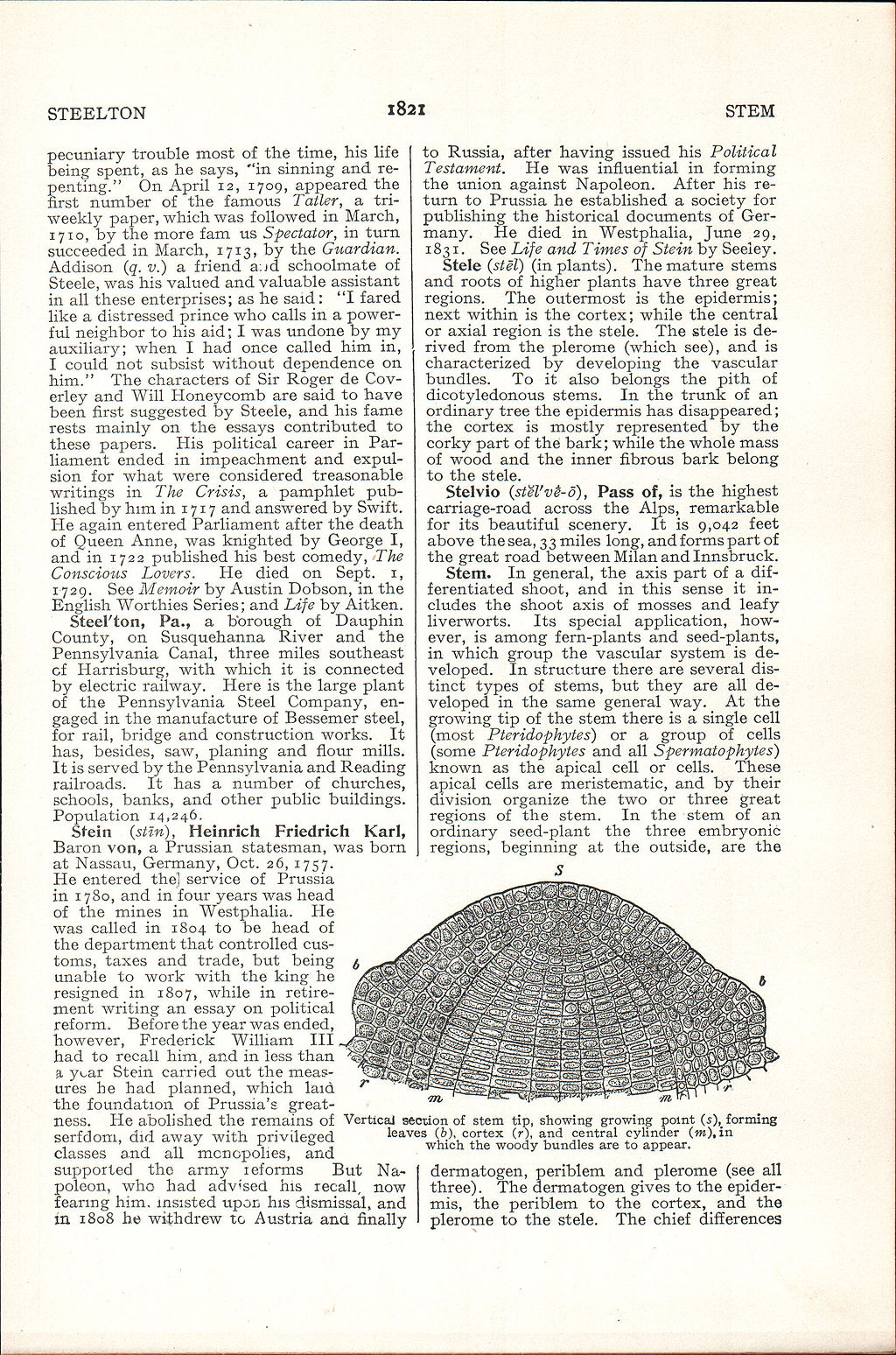STEELTON
l82Z
STEM
pecuniary trouble most of the time, his life being spent, as he says, "in sinning and repenting." On April 12, 1709, appeared the first number of the famous Tatler, a triweekly paper, which was followed in March, 1710, by the more fam us Spectator, in turn succeeded in March, 1713, by the Guardian. Addison (q. v.) a friend aud schoolmate of Steele, was his valued and valuable assistant in all these enterprises; as he said: "I fared like a distressed prince who calls in a powerful neighbor to his aid; I was undone by my auxiliary; when I had once called him in, I could not subsist without dependence on him." The characters of Sir Roger de Cov-erley and Will Honeycomb are said to have been first suggested by Steele, and his fame rests mainly on the essays contributed to these papers. His political career in Parliament ended in impeachment and expulsion for what were considered treasonable writings in The Crisis, a pamphlet published by him in 1717 and answered by Swift. He again entered Parliament after the death of Queen Anne, was knighted by George I, and in 1722 published his best comedy, The Conscious Lovers, He died on Sept. i, 1729. See Memoir by Austin Dobson, in the English Worthies Series; and Life by Aitken.
SteeFton, Pa., a borough of Dauphin County, on Susquehanna River and the Pennsylvania Canal, three miles southeast cf Harrisburg, with which it is connected by electric railway. Here is the large plant of the Pennsylvania Steel Company, engaged in the manufacture of Bessemer steel, for rail, bridge and construction works. It has, besides, saw, planing and flour mills. It is served by the Pennsylvania and Reading railroads. It has a number of churches, schools, banks, and other public buildings. Population 14,246,
Stein (stin), Heinrich Friedrich Karl, Baron von, a Prussian statesman, was born at Nassau, Germany, Oct. 26, 1757. He entered the] service of Prussia in 1780, and in four years was head of the mines in Westphalia. He was called in 1804 to be head of the department that controlled customs, taxes and trade, but being unable to work with the king he resigned in 1807, while in retirement writing an essay on political reform. Before the year was ended, however, Frederick William III had to recall him, and in less than a y^ar Stein carried out the measures he had planned, which laid the foundation of Prussia's greatness. He abolished the remains of serfdom, did away with privileged classes and all monopolies, and supported the army leforms But Napoleon, who had adv'sed his recall, now fearing him, insisted upon his dismissal, and in 1808 he withdrew to Austria ana finally
to Russia, after having issued his Political Testament. He was influential in forming the union against Napoleon. After his return to Prussia he established a society for publishing the historical documents of Germany. He died in Westphalia, June 29, 1831. See Life and Times of Stein by Seeley.
Stele (stel) (in plants). The mature stems and roots of higher plants have three great regions. The outermost is the epidermis; next within is the cortex; while the central or axial region is the stele. The stele is derived from the plerome (which see), and is characterized by developing the vascular bundles. To it also belongs the pith of dicotyledonous stems. In the trunk of an ordinary tree the epidermis has disappeared; the cortex is mostly represented by the corky part of the bark; while the whole mass of wood and the inner fibrous bark belong to the stele.
Stelvio (stel've--d), Pass of, is the highest carriage-road across the Alps, remarkable for its beautiful scenery. It is 9,042 feet above the sea, 33 miles long, and forms part of the great road between Milan and Innsbruck.
Stem. In general, the axis part of a differentiated shoot, and in this sense it includes the shoot axis of mosses and leafy liverworts. Its special application, however, is among fern-plants and seed-plants, in which group the vascular system is developed. In structure there are several distinct types of stems, but they are all developed in the same general way. At the growing tip of the stem there is a single cell (most Pteridophytes) or a group of cells (some Pteridophytes and all Spermatophytes) known as the apical cell or cells. These apical cells are meristematic, and by their division organize the two or three great regions of the stem. In the stem of an ordinary seed-plant the three embryonic regions, beginning at the outside, are the
S
Vertical section of stem tip, showing growing point (5), forming
leaves (6), cortex (r\ and central cylinder (w)tin
which the woody bundles are to appear.
dermatogen, periblem and plerome (see all three). The dermatogen gives to the epidermis, the periblem to the cortex, and the plerome to the stele. The chief differences
